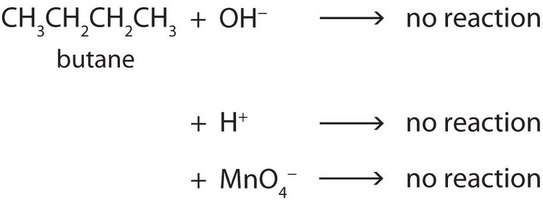1.7: Chemical Properties of Alkanes
- Page ID
- 288532
\( \newcommand{\vecs}[1]{\overset { \scriptstyle \rightharpoonup} {\mathbf{#1}} } \)
\( \newcommand{\vecd}[1]{\overset{-\!-\!\rightharpoonup}{\vphantom{a}\smash {#1}}} \)
\( \newcommand{\id}{\mathrm{id}}\) \( \newcommand{\Span}{\mathrm{span}}\)
( \newcommand{\kernel}{\mathrm{null}\,}\) \( \newcommand{\range}{\mathrm{range}\,}\)
\( \newcommand{\RealPart}{\mathrm{Re}}\) \( \newcommand{\ImaginaryPart}{\mathrm{Im}}\)
\( \newcommand{\Argument}{\mathrm{Arg}}\) \( \newcommand{\norm}[1]{\| #1 \|}\)
\( \newcommand{\inner}[2]{\langle #1, #2 \rangle}\)
\( \newcommand{\Span}{\mathrm{span}}\)
\( \newcommand{\id}{\mathrm{id}}\)
\( \newcommand{\Span}{\mathrm{span}}\)
\( \newcommand{\kernel}{\mathrm{null}\,}\)
\( \newcommand{\range}{\mathrm{range}\,}\)
\( \newcommand{\RealPart}{\mathrm{Re}}\)
\( \newcommand{\ImaginaryPart}{\mathrm{Im}}\)
\( \newcommand{\Argument}{\mathrm{Arg}}\)
\( \newcommand{\norm}[1]{\| #1 \|}\)
\( \newcommand{\inner}[2]{\langle #1, #2 \rangle}\)
\( \newcommand{\Span}{\mathrm{span}}\) \( \newcommand{\AA}{\unicode[.8,0]{x212B}}\)
\( \newcommand{\vectorA}[1]{\vec{#1}} % arrow\)
\( \newcommand{\vectorAt}[1]{\vec{\text{#1}}} % arrow\)
\( \newcommand{\vectorB}[1]{\overset { \scriptstyle \rightharpoonup} {\mathbf{#1}} } \)
\( \newcommand{\vectorC}[1]{\textbf{#1}} \)
\( \newcommand{\vectorD}[1]{\overrightarrow{#1}} \)
\( \newcommand{\vectorDt}[1]{\overrightarrow{\text{#1}}} \)
\( \newcommand{\vectE}[1]{\overset{-\!-\!\rightharpoonup}{\vphantom{a}\smash{\mathbf {#1}}}} \)
\( \newcommand{\vecs}[1]{\overset { \scriptstyle \rightharpoonup} {\mathbf{#1}} } \)
\( \newcommand{\vecd}[1]{\overset{-\!-\!\rightharpoonup}{\vphantom{a}\smash {#1}}} \)
Learning Objectives
- To identify the main chemical properties of alkanes.
Alkane molecules are nonpolar and therefore generally do not react with ionic compounds such as most laboratory acids, bases, oxidizing agents, or reducing agents. Consider butane as an example:

Neither positive ions nor negative ions are attracted to a nonpolar molecule. In fact, the alkanes undergo so few reactions that they are sometimes called paraffins, from the Latin parum affinis, meaning “little affinity.”
Two important reactions that the alkanes do undergo are combustion and halogenation.
Combustion
Nothing happens when alkanes are merely mixed with oxygen (\(O_2\)) at room temperature, but when a flame or spark provides the activation energy, a highly exothermic combustion reaction proceeds vigorously. For methane (CH4), the reaction is as follows:
\[CH_4 + 2O_2 \rightarrow CO_2 + 2H_2O + \text{heat} \label{12.7.1}\]
If the reactants are adequately mixed and there is sufficient oxygen, the only products are carbon dioxide (\(CO_2\)), water (\(H_2O\)), and heat—heat for cooking foods, heating homes, and drying clothes. Because conditions are rarely ideal, however, other products are frequently formed. When the oxygen supply is limited, carbon monoxide (\(CO\)) is a by-product:
\[2CH_4 + 3O_2 \rightarrow 2CO + 4H_2O\label{12.7.2}\]
This reaction is responsible for dozens of deaths each year from unventilated or improperly adjusted gas heaters. (Similar reactions with similar results occur with kerosene heaters.)
Halogenation
Alkanes also react with the halogens chlorine (\(Cl_2\)) and bromine (\(Br_2\)) in the presence of ultraviolet light or at high temperatures to yield chlorinated and brominated alkanes. For example, chlorine reacts with excess methane (\(CH_4\)) to give methyl chloride (\(CH_3Cl\)).
\[CH_4 + Cl_2 \rightarrow CH_3Cl + HCl\label{12.7.3}\]
In larger alkanes there are lots of hydrogen atoms. They are not equally likely to react. The halogen is most likely to replace a hydrogen atom on a tertiary carbon, if present. Secondary carbons are the next most likely, followed by primary carbons. Consider propane. When a molecule of propane reacts with bromine the most likely product is 2-bromopropane. In real life, there wouldn't be just one copy of each molecule so a mixture of products would form. There would be a higher percentage of 2-bromopropane than 1-bromopropane, but both would be present along with HBr.
If enough of the original halogen (e.g. Br2 or Cl2) is available, then the products can continue to react. For example CH3Cl could react with additional Cl2 to create CH2Cl2, CHCl3, and eventually CCl4 if enough chlorine is present.
Fluorine (\(F_2\)), the lightest halogen, combines explosively with most hydrocarbons. Iodine (\(I_2\)) is relatively unreactive. Fluorinated and iodinated alkanes are produced by indirect methods.
Key Takeaway
- Alkanes react with oxygen (combustion) and with halogens (halogenation).
Exercises
- Why do alkanes usually not react with ionic compounds such as most laboratory acids, bases, oxidizing agents, or reducing agents?
- What are the products of the combustion of an alkane? (Assume complete combustion)
- What is the most important reaction of alkanes?
- Name some substances other than oxygen that react readily with alkanes.
Answers
- Alkanes are nonpolar; they do not attract ions.
- Water and carbon dioxide.
- Combustion because it is used to create heat for homes, grills, etc.
- Halogens, especially chlorine and bromine.

